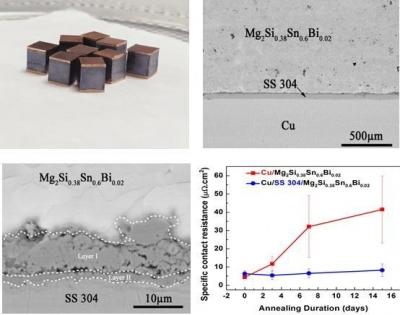Low-cost electrical contact material developed for thermoelectric devices
By IANS | Published: July 20, 2021 07:57 PM2021-07-20T19:57:08+5:302021-07-20T20:25:53+5:30
New Delhi, July 20 Researchers have developed a new low-cost electrical contact material for thermoelectric devices that is ...

Low-cost electrical contact material developed for thermoelectric devices
New Delhi, July 20 Researchers have developed a new low-cost electrical contact material for thermoelectric devices that is stable at high temperature and gives more than 10 per cent conversion efficiency.
Researchers from the International Advanced Research Centre for Powder Metallurgy & New Materials (ARCI), an autonomous institute of the Department of Science & Technology, have designed and developed thermoelectric modules using lead telluride (PbTe) and magnesium stannite silicide (Mg2Si1-xSnx) compounds, a release from the Union Science and Technology Ministry said on Tuesday.
This work has been published in the journal 'Materials Research Bulletin' recently.
A thermoelectric material can generate electricity by using a temperature difference between its two sides. A thermoelectric device can also function as a small heat pump, moving heat from one side of the device to the other.
Thermoelectric materials convert thermal energy directly into electricity through a process that involves a solid-state electron and photon diffusion process. Though the principle is known for two centuries, it had limited utility as most known thermoelectric materials' energy conversion efficiency is very low. Nanotechnology brought innovations to improve the efficiency of materials, but the mass-market application of such innovations has remained restricted due to the low device conversion efficiency of 6-10 per cent. This makes the electricity produced costlier than other technologies.
The current study synthesised the bismuth-doped magnesium silicide stannide powder by induction melting of constituent elements and ball milling of the solidified ingots was hot-pressed with SS304 and copper (Cu) powders. The joint's specific contact resistance is around 4.4 uU.cm2, which is the lowest value reported so far in this material, the release said, adding, "The joint showed excellent thermal stability up to 450 degrees Celsius temperature when tested for 15 days, with insignificant change in the reaction layers' thickness at the interface.
The study can be accessed here: https://doi.org/10.1016/j.materresbull.2020.111147
Disclaimer: This post has been auto-published from an agency feed without any modifications to the text and has not been reviewed by an editor
Open in app